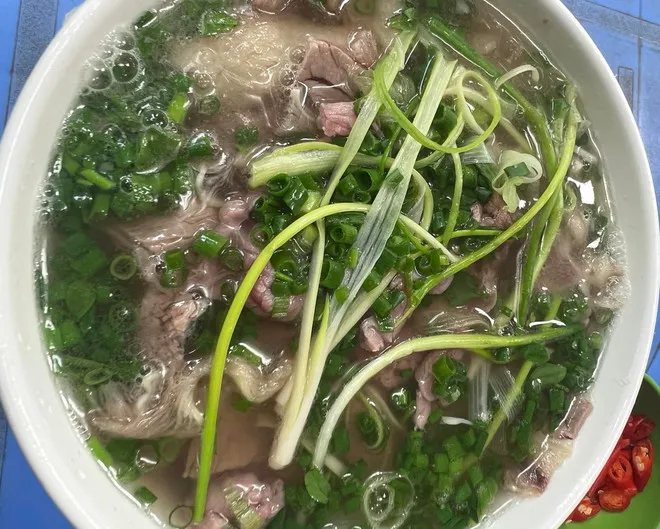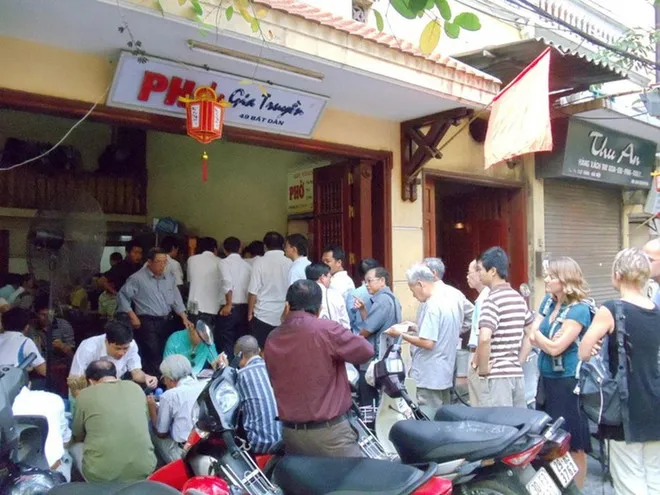Pho, Vietnam’s national dish, is more than just food; it’s a cultural icon, a culinary symbol renowned worldwide. Amidst countless pho variations across Vietnam, Hanoi Pho holds a special place, considered the standard, the epitome of Vietnamese pho. CNN recognized Hanoi Pho as one of the world’s 50 best dishes in 2018, a testament to its irresistible appeal.
Hanoi Pho: From Street Vendors to International Culinary Icon
Few know that Hanoi Pho’s origins are tied to street vendors roaming the city’s streets. Affectionately known as “pho ganh” (street vendor pho), it was a unique characteristic of old Hanoi. The clear calls of vendors and steaming pho stalls became cherished memories of Hanoi. Although street vendor pho is less common today, with only a few remaining in the Old Quarter, the flavor and value of Hanoi Pho remain intact, undiminished by time.

A delicious and flavorful bowl of Hanoi beef pho with traditional taste. (Image: Vietnam+)
Hanoi Pho has conquered not only domestic diners but also reached global audiences. From Japan, the US, Australia to Europe and Africa, Hanoi pho restaurants can be found, spreading the taste of home and promoting Vietnamese culinary culture. The presence of Hanoi Pho on the world culinary map has affirmed its solid position and enduring appeal.
The Secret to Hanoi Pho’s Distinctive Flavor
What makes Hanoi Pho so different and captivating? The secret lies in the meticulousness of each step, from selecting fresh ingredients to skillful cooking techniques.
Broth – The Soul of Pho: Hanoi pho broth must be clear, subtly sweet, and rich with the flavor of simmered beef bones and signature spices like star anise, cardamom, cinnamon, cloves, roasted ginger, and roasted onion. The bone simmering process lasts for hours, even days, to extract all the essence, creating a fragrant, golden broth that delights everyone.
Pho Noodles – Soft and Delicate Strands: Traditional Hanoi pho noodles are made from high-quality white rice, thinly sheeted, and cut into medium-sized strands, soft but not mushy. These fresh, white noodles, when soaked in hot broth, become tender and fully absorb the delicious flavor of the soup.
Beef – Diverse Choices, Exquisite Flavors: Hanoi beef pho has many appealing variations such as pho tai (rare beef), pho chin (well-done beef), pho nam (brisket), pho gau (fatty brisket), pho tai lan (stir-fried rare beef). Each type of beef offers a different taste experience, from tender rare beef and rich well-done beef to flavorful brisket and crunchy fatty brisket. The beef is thinly sliced, blanched rare or simmered tender depending on the pho type, ensuring freshness and distinctive flavor.
Herbs and Spices – Perfect Accents: Herbs served with Hanoi pho are also diverse, including scallions, cilantro, Thai basil, and bean sprouts. Essential condiments include chili sauce, fresh lime, black pepper, and vinegar garlic, allowing diners to customize their bowl to their liking, creating a personalized and flavorful experience.
Enjoying Hanoi Pho the Authentic Way: From Humble Eateries to Luxury Restaurants
Hanoi Pho can be enjoyed everywhere, from humble sidewalk eateries and street vendors to luxurious, high-end restaurants. Wherever you are, Hanoi Pho retains its distinctive, refined flavor, satisfying every palate.
To enjoy Hanoi pho authentically, it’s best eaten hot, immediately after the broth is ladled in. Pick up a soft strand of pho noodle, accompanied by a fragrant piece of beef, soaked in subtly sweet broth, add a few herbs, a squeeze of lime, and a dash of chili sauce… all harmonizing to create a symphony of flavors, awakening every sense.

Customers queue to buy pho at the famous Bat Dan Pho restaurant. (Image: Vietnam+)
Recommended Famous Pho Restaurants in Hanoi:
- Pho Bat Dan (49 Bat Dan, Hoan Kiem): A family-run pho restaurant over 100 years old, famous for its rich broth and distinctive traditional flavor. Pho Bat Dan is always crowded, especially during peak hours, often requiring customers to queue for their turn to enjoy.
- Pho Ganh (Hang Duong – Hang Chieu intersection, Hoan Kiem): Famous for its unique pho sot vang (pho with red wine sauce), with a rich, delicious flavor from bone broth and smooth red wine sauce. Pho Ganh attracts diners with its generous portions, hot broth, and distinctive flavor that is unmistakable.
- Pho Thin Lo Duc (13 Lo Duc, Hai Ba Trung): A long-standing pho restaurant, known for its renowned pho bo tai lan (stir-fried rare beef pho). Pho Thin’s specialty is abundant scallions, tender and flavorful stir-fried rare beef, and a characteristic rich broth.
- Pho 10 Ly Quoc Su (10 Ly Quoc Su, Hoan Kiem and multiple locations): A famous pho chain with many locations throughout Hanoi. Pho 10 Ly Quoc Su captivates diners with its clear, sweet broth, fresh beef, soft noodles, and spacious, modern restaurant setting.
Traditional Hanoi Beef Pho Recipe
If you want to make delicious Hanoi beef pho at home, refer to this traditional family recipe:
Ingredients:
- Beef bones (leg bones): 1kg
- Beef brisket: 500g (or shank, fatty brisket, optional)
- Rare beef slices: 300g
- Fresh pho noodles: 1kg
- Onions: 2
- Ginger: 1 knob
- Shallots: 2
- Spices: Star anise, cardamom, cinnamon stick, cloves, coriander seeds (roasted), salt, sugar, MSG, seasoning powder, fish sauce (use sparingly to avoid souring the broth).
- Herbs: Scallions, cilantro, Thai basil, bean sprouts.
- Condiments: Lime, chili sauce.
Instructions:
- Prepare Ingredients:
- Rinse beef bones and brisket, cut bones into segments. Soak bones and brisket in salt water for about 2 hours to deodorize and clean.
- Char onions, shallots, and ginger for aroma.
- Roast star anise, cardamom, cinnamon stick, cloves, and coriander seeds until fragrant.
- Simmer Broth:
- Blanch beef bones and brisket in boiling water, rinse again.
- Place beef bones and brisket in a pot, cover with cold water. Bring to a boil, skim off scum thoroughly.
- Add charred onion, ginger, star anise, cardamom, cinnamon stick, cloves, and coriander seeds to the broth.
- Season with salt, sugar, seasoning powder, and MSG to taste. Simmer over low heat for about 1.5 – 2 hours.
- Remove brisket before it becomes too tender. Soak brisket in a bowl of cooled boiled water to retain moisture, then slice thinly.
- The broth is ready when it is clear, light golden in color, fragrant with spices, and subtly sweet from the bones.
- Prepare Noodles and Herbs:
- Blanch pho noodles in boiling water until soft and hot.
- Wash herbs, chop scallions and cilantro. Thinly slice onion.
- Assemble:
- Place pho noodles in a bowl, top with sliced brisket, rare beef (quickly blanched), onion, and herbs.
- Ladle hot broth into the bowl.
- Enjoy Hanoi beef pho while hot, with lime and chili sauce.
Conclusion: Hanoi Pho – More Than Just a Dish
Hanoi Pho is not just a delicious dish, but also a part of culture, history, and the pride of Hanoi residents and the Vietnamese nation. The flavor of Hanoi pho has captured the hearts of many, from those living far from home to international visitors. Enjoying a bowl of Hanoi pho is not just a culinary experience, but also a journey to discover culture, and feel the soul of a thousand-year-old Hanoi. Come to Hanoi and experience the renowned flavor of pho for yourself, to fully appreciate the essence of Vietnamese cuisine!